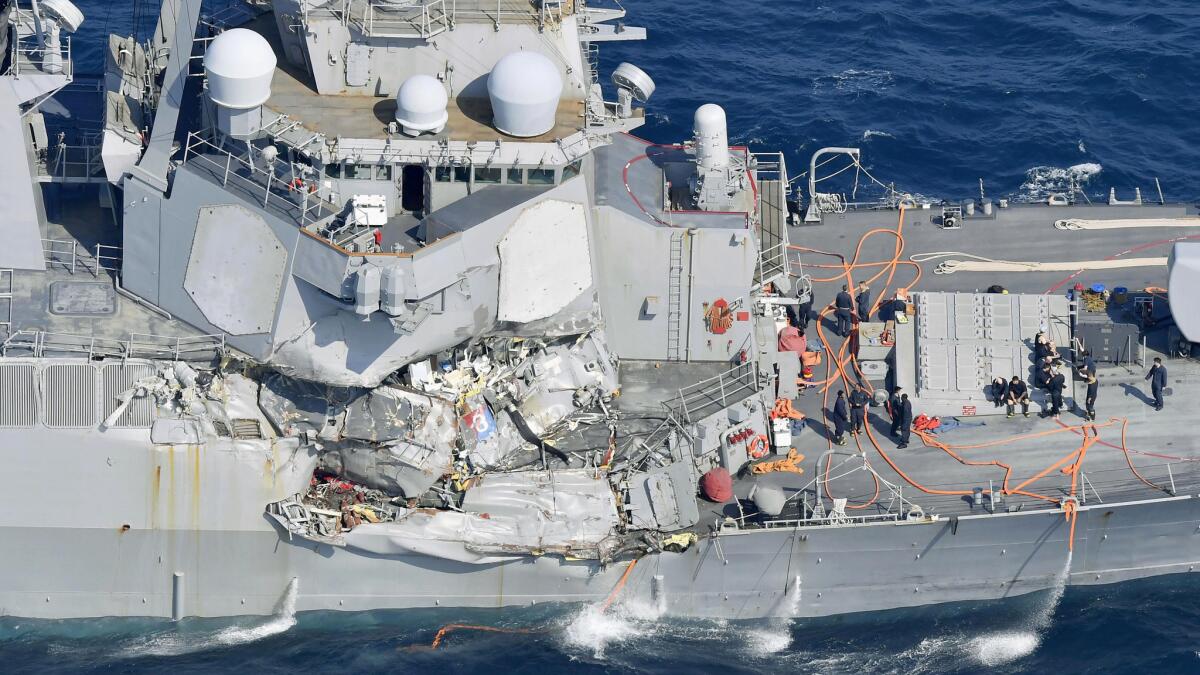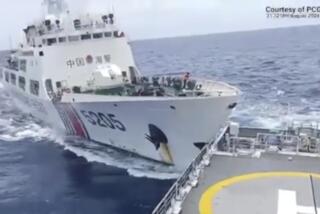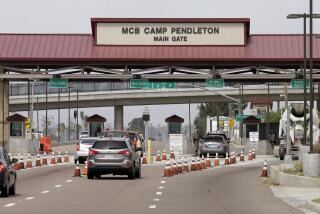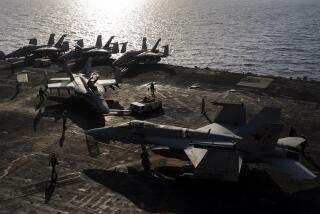Trump to visit Pacific military command embroiled in controversy

- Share via
Reporting from Washington — Two days after the Navy blamed sloppy seamanship and navigational blunders for two “avoidable” collisions at sea that killed 17 sailors this summer, President Trump flies to Hawaii on Friday to visit the Pentagon’s troubled Pacific Command.
Trump will get a briefing at command headquarters in Honolulu and visit the battleship Arizona memorial at Pearl Harbor before he leaves for his first official visit to Asia, where he will visit Japan, South Korea, China, Vietnam and the Philippines.
Pacific Command oversees U.S. military operations in the Pacific and Indian Oceans, including those near North Korea and China. But it has been the focus of intense concern at the Pentagon and in Congress this year for a series of major failures.
The Obama administration added U.S. Marines and ships to the Pacific fleet as part of what it called a strategic rebalance. Trump has not announced any changes to those policies and has not publicly commented on the problem-plagued Pacific Command.
The Navy publicly embarrassed the White House in April when a spokesman said it was sending an aircraft carrier task force into the Sea of Japan as a show of force against North Korea, fanning fears of a potential conflict with the nuclear-armed nation.
It turned out the carrier, the Carl Vinson, and the three other warships in its strike force were actually sailing in the opposite direction to take part in joint exercises with the Australian Navy in the Indian Ocean, 3,500 miles southwest of the Korean Peninsula.
The Pentagon later blamed an ill-timed announcement by Pacific Command and other miscommunications for the mix-up. The Vinson subsequently reported to duty off Korea.
Other than North Korea, the chief hot spot is the resource-rich South China Sea. China has built up a handful of reefs and shoals into strategic outposts with runways and military installations, deepening long-standing maritime and territorial disputes with neighboring nations.
In response, the Navy has stepped up what it calls freedom of navigation operations, sending warships and aircraft on patrols near the disputed islands.
But the more immediate concern has been what the Navy called preventable accidents at sea this year involving four large U.S. warships in the western Pacific.
Seven sailors were killed aboard the guided-missile destroyer Fitzgerald on June 21 when it collided with a container ship off the southern coast of Japan. Ten others died on the John S. McCain, another guided-missile destroyer, when it was rammed by an oil tanker in busy sea lanes near Singapore on Aug. 21.
The sailors all were crushed or drowned, many as they slept in their berths, according to the 72 pages released Wednesday.
“These accidents were preventable and the respective investigations found multiple failures by watch standers that contributed to the incidents,” Adm. John M. Richardson, chief of naval operations, said in a statement. “We must do better.”
The Navy has fired senior officers on the Fitzgerald and McCain, and two other admirals decided to retire early because their prospects for promotion were quashed.
More significantly, Vice Adm. Joseph Aucoin, commander of the Navy’s 7th Fleet, where both ships were assigned, was also sacked “due to a loss of confidence in his ability to command.”
Aucoin was the highest-ranking commander to be dismissed for an operational issue since Adm. Husband Kimmel, commander of Pacific Fleet, lost his job after Japanese aircraft attacked Pearl Harbor in 1941, bringing America into World War II.
In addition to the two collisions this year, the Lake Champlain, a guided-missile cruiser, crashed into a South Korean fishing boat, and the Antietam, another guided missile cruiser, ran aground in Tokyo Bay. They suffered damage but there were no serious injuries.
The Navy reports blamed a mix of poor leadership, equipment failures, inadequate training and high operational tempo for the accidents.
The description of the McCain’s predawn crash with the Alnic MC, a much larger oil tanker, was especially vivid.
“The collision was felt throughout the ship,” the report said. “Some sailors thought the ship had run aground, while others were concerned that they had been attacked. Sailors in parts of the ship away from the impact point compared it to an earthquake. Those nearest the impact point described it like an explosion.”
It said many of the decisions that led to the collision “were the result of poor judgment and decision making of the commanding officer,” the report added. “That said, no single person bears full responsibility for this incident. The crew was unprepared for the situation.”
James Stavridis, a retired admiral who is now dean of the Fletcher School of Law and Diplomacy at Tufts University, called the “seagoing disasters” and subsequent fallout “unprecedented.”
“The Navy needs to continue to move methodically and unemotionally to sort out root causes, reverse engineer them, and kill the pattern of mistakes,” he said.
The collisions also gave China a new way to criticize America’s military presence in the Pacific, long a sore point with Beijing. The Chinese foreign ministry has said U.S. warships pose a “security threat” to civilian vessels, a disparagement that has echoed across Chinese state-run media.
“The Chinese have seized upon these accidents as a way to say that the U.S. is destabilizing the region,” said Ely Ratner, an expert on China at the nonpartisan Council on Foreign Relations.”It has allowed them to turn the tables and say the U.S. is the one who’s the provocateur in the region.”
A Government Accountability Office report issued in September found numerous problems in the Navy, including “deployment lengths, shortened training periods, and reduced or deferred maintenance to meet high operational demands, which has resulted in declining ship conditions and a worsening trend in overall readiness.”
A key finding was that 37% of certifications, including for seamanship, for Pacific naval cruisers and destroyers had expired. Another finding highlighted that sailors often worked 100-hour-plus weeks that contributed to safety risks.
Naval officers and outside analysts blamed the shortfalls, in part, on the Navy’s “can-do” attitude, complacency and overconfidence.
“There is a cultural factor here, where you’re more dedicated if you can stay awake,” Richardson, the Navy’s top officer, told a recent Senate hearing. “It’s like pulling an all-nighter in college.”
Sen. John McCain (R-Ariz.), chairman of the Senate Armed Services Committee and son and grandson of the McCain’s namesakes, said the Navy has promised corrective training and other steps to prevent future accidents.
“Time is of the essence in fixing the problems, and Congress must provide the necessary resources in a timely and predictable manner,” he said in a statement. “The failure to properly fund, train and equip our military directly contributed to these collisions.”
Twitter: @wjhenn
ALSO:
U.S. special operations forces face growing demands and increased risks
The U.S. is launching ‘danger-close’ drone strikes so risky they require Syrian militia approval
More to Read
Get the L.A. Times Politics newsletter
Deeply reported insights into legislation, politics and policy from Sacramento, Washington and beyond. In your inbox three times per week.
You may occasionally receive promotional content from the Los Angeles Times.











